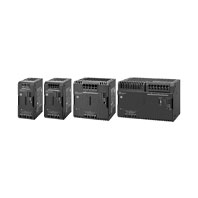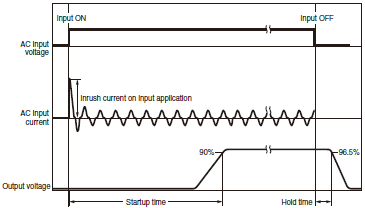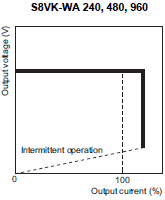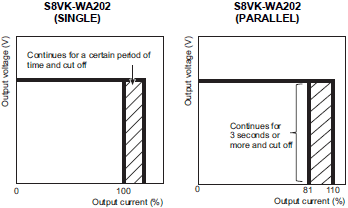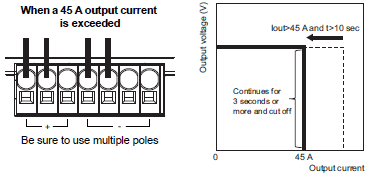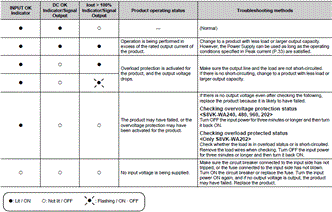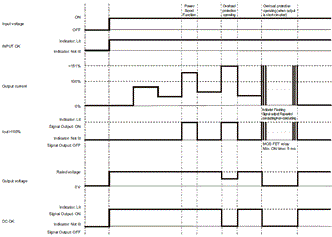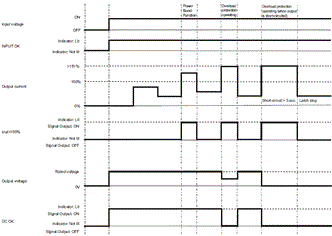| Power rating | 240 W | 480 W | 960 W | ||
|---|---|---|---|---|---|
| Output voltage (VDC) | 24 V | 24 V | 24 V | ||
| Efficiency *1 | Three-phase
200 VAC input |
93% typ. | 94% typ. | 95% typ. | |
| Single-phase/
two-phase 200 VAC input |
92% typ. | 93% typ. | 94% typ. | ||
| Three-phase
230 VAC input |
93% typ. | 94% typ. | 95% typ. | ||
| Single-phase/
two-phase 230 VAC input |
93% typ. | 94% typ. | 95% typ. | ||
| Input con-
ditions |
Input voltage range *2 | Three-phase/single-phase/two-phase
170 to 264 VAC, 265 to 300 VAC (1 second) 240 to 350 VDC |
|||
| Frequency *2 | 50/60 Hz (47 to 63 Hz) | ||||
| Input current
*1 |
Three-phase
200 VAC input |
0.80 A typ. | 1.6 A typ. | 3.1 A typ. | |
| Single-phase/
two-phase 200 VAC input |
1.4 A typ. | 2.6 A typ. | 5.2 A typ. | ||
| Three-phase
230 VAC input |
0.70 A typ. | 1.4 A typ. | 2.7 A typ. | ||
| Single-phase/
two-phase 230 VAC input |
1.2 A typ. | 2.3 A typ. | 4.5 A typ. | ||
| Power factor *1 | 0.9 min. | ||||
| Leakage
current *3 |
Three-phase
200 VAC input |
1 mA max. | |||
| Three-phase
230 VAC input |
1 mA max. | ||||
| Inrush
current *4 (for a cold start at 25°C) |
Three-phase
200 VAC input |
13 A typ. | 13 A typ. | 14 A typ. | |
| Three-phase
230 VAC input |
15 A typ. | 15 A typ. | 16 A typ. | ||
| Output
character- istics |
Rated output current | 10 A | 20 A | 40 A | |
| Power Boost Function | 15 A | 30 A | 60 A | ||
| Voltage adjustment range *5 | 24 to 29.5 V (with V.ADJ) | 24 to 28 V (with V.ADJ) | |||
| Ripple noise
voltage *6 |
Three-phase
200 to 240 VAC input |
50 mVp-p max.
at 20 MHz of bandwidth |
120 mVp-p max.
at 20 MHz of bandwidth |
60 mVp-p max.
at 20 MHz of bandwidth |
|
| Input variation influence *7 | 0.5% max. | ||||
| Load variation influence *8 | 1.5% max. | ||||
| Temperature
variation influence |
200 to 240
VAC input |
0.05%/°C max. | |||
| Startup
time *9 |
Three-phase
200 VAC input |
1,000 ms max. | |||
| Three-phase
230 VAC input |
1,000 ms max. | ||||
| Output hold
time *9 |
Three-phase
200 VAC input |
35 ms typ. | 30 ms typ. | 25 ms typ. | |
| Three-phase
230 VAC input |
35 ms typ. | 30 ms typ. | 25 ms typ. | ||
| Additional
functions |
Overload protection | Yes, automatic reset, intermittent operation type
Refer to Overload Protection below. |
|||
| Overload protection for
terminals |
No | ||||
| Overvoltage protection | Yes, 130% or higher of rated output voltage, power shut off (shut off
the input voltage and turn on the input again), Refer to Overvoltage Protection below. |
||||
| Series operation | Yes (For up to two Power Supplies; external diodes required.) | ||||
| Parallel operation | Yes (For up to two Power Supplies), Refer to Parallel Operation on
Data sheet. |
||||
| INPUT OK Indicator | Yes (LED: Green) | ||||
| DC OK Indicator | Yes (LED: Green) | ||||
| Iout > 100% Indicator | Yes (LED: Yellow) | ||||
| DC OK Signal Output | Yes (MOS FET relay output 30 VDC max., 50 mA max.) | ||||
| Iout > 100% signal output | Yes (MOS FET relay output 30 VDC max., 50 mA max.) | ||||
| Insulation | Withstand voltage | 3.0 kVAC for 1 min. (between all input terminals and all output terminals,
signal output terminals), cutoff current 20 mA |
|||
| 2.0 kVAC for 1 min. (between all input terminals and PE terminals),
cutoff current 20 mA |
|||||
| 1.0 kVAC for 1 min. (between all output terminals, signal output terminals
and PE terminals), cutoff current 25 mA (240 W/480 W/960 W) 1.0 kVAC for 1 min. (between all output terminals, signal output terminals and PE terminals), cutoff current 40 mA (2000 W) |
|||||
| 0.5 kVAC for 1 min. (between all output terminals and all signal output
terminals), cutoff current 10 mA |
|||||
| Insulation resistance | 100 MΩ min. (between all output terminals, signal output terminals
and all input terminals / PE terminals) at 500 VDC |
||||
| Environ-
ment |
Ambient operating
temperature *10 |
-40 to 70°C (Derating is required according to the temperature.
Refer to Engineering Data on Data sheet.) (with no condensation or icing) |
|||
| Storage temperature | -40 to 85°C (with no condensation or icing) | ||||
| Ambient operating humidity | 95% max. (Storage humidity: 95% max.) | ||||
| Vibration resistance *11 | 10 to 55 Hz, maximum 5 G, 0.42 mm single amplitude for 2 h each in
X, Y, and Z directions |
||||
| Shock resistance *11 | 294 m/s2, 3 times each in ±X, ±Y, ±Z directions | ||||
| Reliability | MTBF *12 | 290,000 hrs typ. | 230,000 hrs typ. | 170,000 hrs typ | |
| Expected life *13 | 10 years min. | ||||
| Construc-
tion |
Weight | 800 g max. | 1,050 g max. | 1,750 g max. | |
| Cooling fan | No | ||||
| Degree of protection | IP20 by EN/IEC 60529 | ||||
| Standards | Harmonic current emissions | Conforms to EN 61000-3-2 (single-phase, two-phase *14)
Complies with JIS C 61000-3-2 (single-phase, two-phase, three-phase) |
|||
| EMI | Conducted
emissions |
Conforms to EN 61204-3 Class B,
EN 55011 Class B (three-phase) Conforms to EN 61204-3 Class A, EN 55011 Class A (single-phase, two-phase) |
Conforms to EN 61204-3 Class B,
EN 55011 Class (three-phase) Conforms to EN 61204-3 Class B, EN 55011 Class (single-phase, two-phase *16) Conforms to EN 61204-3 Class EN 55011 Class A (single-phase, two-phase) |
||
| Radiated
emissions |
|||||
| EMS | Conforms to EN 61204-3 high severity levels | ||||
| Safety standards | • UL 508 (Listing)
• CSA C22.2 No.107.1 (cUL) • UL 62368-1 (Recognition) OVC II (≤ 3000 m) Pol2 • CSA C22.2 No.62368-1 (cUR) OVC II (≤ 3000 m) Pol2 • EN/IEC 62477-1 OVC III (≤ 2000 m) OVC II (2000 m < and ≤ 3000 m) Pol2 • EN/IEC 62368-1 OVC II (≤ 3000 m) Pol2 • RCM (EN61000-6-4) • Complies with PELV (EN/IEC 60204-1) • Complies with EN/IEC 61558-2-16 |
||||
| SEMI | Complies with SEMI F47-0706 (three-phase / single-phase / two-phase
200 to 240 VAC input) |
||||
